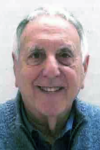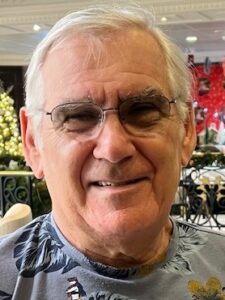By Donald H. Harrison


AT SEA, Aboard Azamara Onward – Last year, forensic expert Miguel Lorente said a DNA test of the bones on view at Seville Cathedral indicated that Christopher Columbus was a Sephardic Jew from Western Europe.
But what of another cache of bones also said to be those of the controversial 15th century explorer that are kept in a mausoleum at the Faro a Colón (Columbus Lighthouse) in Santo Domingo, Dominican Republic? Authorities in the Dominican Republic so far have refused to submit them to DNA testing.
If eventually authorities do permit testing, what will they reveal? asks Hal Tinberg, Ph.D., who has been lecturing on forensics on this cruise ship as it makes its way on a transcanal voyage from Miami, Florida, to San Diego, California.
Will they prove to be from a different person than the bones in Seville, Spain? Or will they in fact be the bones from the same man, who previously had been thought to have been an Italian, born in Genoa? Neither ossuary contains a complete skeleton, so it’s possible that they are from the same man.
Columbus died in 1506 in Valladolid, Spain. According to historical records, 36 years later, his remains were transported to the Dominican Republic, where they remained for 253 years before some were transported to Cuba in 1795. After 103 years, some bones were transported to the Cathedral in Seville, where they have remained since 1898.
Tinberg said considerable non-forensic evidence points to Columbus’s Jewish origins.
“In 1492, Jews were expelled by a very nasty Queen Isabella — much nastier than her husband King Ferdinand – to turn the country into a Catholic monarchy,” Tinberg related in an interview. “He (Columbus) petitioned Isabella to do a voyage to the New World. She didn’t finance that voyage, although history books say that Ferdinand and Isabella gave him that money. No, the money was all raised by very rich Jews in Spain.”
“Many of his crew members were of Jewish descent. … so, there were a lot of Jews on board the Nina, the Pinta and the Santa Maria,” Tinberg continued. “Some people feel that Columbus was actually Jewish, and he posed as an Italian but he was actually from Catalonia. To get these ships and take all of these Jews who were in danger of their lives from the Inquisition and get them to … where they would be safe.”
Tinberg, who is Jewish, noted that the Jewish world is not exactly rejoicing over the news that Columbus had Jewish roots. “The problem with Columbus is that he wasn’t really a nice guy,” he said. “He treated indigenous people very badly. He treated his own crew members very badly. The king actually put him in chains on one of his voyages back because of the mistreatment … Columbus was later pardoned, the chains were removed, and he was back in good stead.”
Another clue to Columbus’ Jewish identity, Tinberg said, was that “he had a little thing in his signature that looked like Hebrew writing that confused people– is that Hebrew or what? — and only he had that in his signature, nobody else had. He actually decreed that only he could use that, not even his own relatives could use that signet.”
Why, if Columbus was a Jew from Catalan, did historians over the centuries say that he was born in Genoa in 1451?
“That is historical; there are public records that say he was,” Tinberg responded. “The big problem with Columbus is that from the time he was in his late teens to when he got to be 30ish, there is nothing written about him. He disappeared, like he went into protection.
“Then he reappeared, and some people believe that the new guy was a different person; that in fact there were two Columbuses. One was from Genoa, the historical Columbus, and the other was from Catalan, the guy who smuggled the Jews out of Spain. Whether any of that is true, nobody will know because there is no access to bones. Maybe Lorente, who is still working on it, can find what ethnic markers there are in the DNA” in the bones of the Dominican Republic’s ossuary.
*
Tinberg grew up in the Fairfax neighborhood of Los Angeles and commuted to UCLA, where he specialized in the study of cell biology in the Zoology Department, earning a BA in 1968 and a PhD in 1971. From there, he did post-doctoral studies in biophysics at UC Berkeley while also working as a researcher into alcoholic liver disease at the VA Hospital in Martinez. During the next decade, he also transferred to a VA Hospital in Loma Linda, Southern California.
“And then I jumped to industry, and I went to work for a diagnostic company, which I spent a year, maybe two years working for, working on imino acids. I joined Abbott Labs in 1985 and started off in their small plant in Pasadena … Then I transferred to their Dallas facility and was working on clinical chemistry and hospital tests. One day my boss came in and said ‘we are moving you to Chicago’ and that was in 1989, and I said, ‘can I talk it over,’ and she said ‘no, you can’t talk it over. you’re going to be moving to Chicago.’ So, I moved to Chicago, to their headquarters at Abbott Park, Illinois, and that (the Chicago area) is where I have been ever since.”
He retired in 2002, afterwards volunteering to teach children about science at a museum and teaching community college classes. He also became a student in art classes which produced works that are all over his home. He met a woman on a golf course who told him she had become a lecturer on cruise ships, and he thought he’d like to do that.
“I had a life science background, and I could do a lot more than talk about lab tests,” Tinberg reflected. So, he wrote to the lady’s contact in Florida, “filled out my resume and about a week later I got an email from her. … I had suggested to her in my application that I wanted to do forensic talks because CSI at the time was the number one television show in the country. With everyone watching it, it built an audience. She wrote back, ‘you’re in luck, my forensic person left and how would you like to go on a cruise in August?’ It was probably then June.
“All I had submitted to her were titles; I hadn’t written a thing yet,” Tinberg recalled. “When she said okay, I had to put together four talks real fast. I went on my first cruise; it was a lot of fun. I lectured in a dining room annex in a smaller ship, had 18 people at my talks and they all seemed very happy with the talks.
“I have been doing cruise ships now for 17 years – since 2007, though I took a break during the pandemic … I have been on 120 some cruises and 18 on this particular line (Azamara) that I am on now.”
*
Donald H. Harrison is publisher and editor of San Diego Jewish World.
What is wrong about these Columbus articles is these types of paragraphs that are treated as if it is historical fact. This man knows nothing about Columbus or these circumstances. What he does is just repeat the smears and lies about this historical explorer to make himself sound like an authority. This entire article is nothing but speculation and silliness. Tinberg, who is Jewish, noted that the Jewish world is not exactly rejoicing over the news that Columbus had Jewish roots. “The problem with Columbus is that he wasn’t really a nice guy,” he said. “He treated indigenous people very badly. He treated his own crew members very badly. The king actually put him in chains on one of his voyages back because of the mistreatment … Columbus was later pardoned, the chains were removed, and he was back in good stead.”